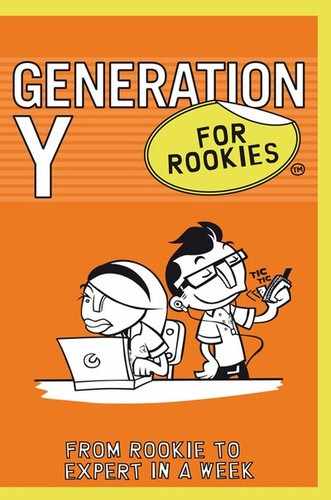CHAPTER 9
How to appeal to Gen Y
consumers
Generation Y as a market
I first became aware of Generation Y as a market when I was working in the media industry for The Economist Group (publisher of The Economist newspaper). Marketing people and advertisers realized that this generation was quite different, in terms of their attitudes and values, from consumers of other ages. They started to take steps to understand Gen Y so that they could appeal to them.
The so-called “grey market” is very important to many organizations these days, because the population is ageing, and this age group often has more time and disposable income. But some organizations and sectors are either losing or not gaining young consumers at the rate they need to in order to sustain and grow their businesses. The media industry is exercising its brains about this as technology changes and consumers start to use media content in very different ways. The electronics products industry has transformed into the “digital entertainment” industry. Other industries are perhaps not yet taking such a radical look at their business models and product offerings as the media and the electronics industries have. But even if their products do not need to change in the next few years, they will certainly have to look at the ways they communicate with and market and sell to their consumers and customers. To understand their Gen Y consumers (and those of other ages who have similar behaviours to Gen Y due to the technological changes), they will have to get a deep insight into their values, needs and preferences.
Gen Y is just a manifestation of a profound and fundamental technological change that is picking up pace in the world as more people get connected and more organizations adjust their business models. This is important to remember, because some people think that Gen Y are going to change and become more like Boomers and Gen X. They won’t, because they have grown up in a very different technological paradigm that is driving some important changes in people’s attitudes and behaviour.
 Rookie Buster
Rookie Buster
Some people think that Gen Y are going to change and become more like Boomers and Gen X. They won’t.
As we have seen, Gen Y are natives of the digital world; the rest of us are immigrants. They will always have more of an inherent, natural understanding of the digital world than we do because they have always used technology. Boomers and Gen X are digital immigrants – and just like people who learn a new language, they will always need to translate the new language into their own to a greater or lesser extent. We will take a closer look at this and its implications later.
In this chapter we are going to take a look inside the minds of Gen Y. You will learn about what makes them tick, and gain an understanding of how to appeal to, and do business with, your current and potential Gen Y consumer or customer base.
 Rookie Buster
Rookie Buster
Generation Y are natives of the digital world; the rest of us are immigrants.
The essentials – what do you really
need to understand about Gen Y?
The most important thing you need to understand is the context that Gen Y have grown up and been educated in. This understanding will give you an insight into their behaviour. When you visit a country whose culture is very different from your own, it is not enough to understand the local people’s habits and manners. To really get an insight into what makes them tick, you need to understand the underlying values that create the behaviour (or habits). If you don’t, you will only have a shallow understanding and will not gain any insight into why people are as they are.
For example, you may well know that some people in the UK who are currently in their eighties tend not to buy premium food brands. If you are a marketer of premium food brands, you may try and find all sorts of ways to appeal to this group and entice them to buy. But you need insight into why they don’t buy these brands. You may find that because World War II and food rationing were happening during their formative years, they believe that spending money on premium food brands is a waste of money. However, premium food brands are also very appealing to some people in that age group simply because those foods were not available when they were growing up.
In Chapter 1 we looked at the context in which Gen Y grew up in order to understand how that has shaped their behaviour.
As marketing people know only too well, human behaviour is a complex thing. It is difficult to define and predict. And it is important to understand your target market as much as you possibly can in order to avoid making dangerous assumptions about them. That said, here are some of the essentials that you need to know about Gen Y if you are to appeal to them and attract and keep hold of Gen Y consumers and customers:
• They have very good spin detectors. For a number of reasons, Gen Y are much less susceptible to spin than Boomers and Gen X are. They have witnessed the corporate scandals of the last decade and have seen the decline in trustworthiness of business people and politicians. They are used to a straightforward communication style, because internet usage means they are accustomed to clicking on and off websites to find what is relevant to them. Websites have just seconds to get their message across, so the copy on these sites is much more succinct and to the point. Gen Y want to know “what’s in it for them” quickly. And they have low tolerance for overstated or false claims.
 Rookie Buster
Rookie Buster
Gen Y are much less susceptible to spin than Boomers and Gen X are.
• Openness and honesty is important to them. They appreciate and demand honesty as much as they shun spin. One of the reasons why Obama got the young generation’s vote was that he represented an openness and honesty that they had not seen in other politicians. He used Facebook to win them over, to appear accessible and to talk to them in their preferred medium. They have learned to trust people they don’t know by doing business with them on websites such as eBay and Amazon. These sites operate on openness and trust. And that honesty is monitored and rated by the consumers themselves.
• They are quick to decide what is relevant to them and what is not. You don’t have much time to grab their attention. They are used to having a stream of communications at their fingertips, so they are accustomed to sifting out what is not applicable to them or does not immediately interest them.
• They are used to having choice. There is a proliferation of websites that compare products and services and help consumers to make choices. Increasingly consumers do not have to buy standard products. Having to accept “standard” products or services does not make sense to Gen Y. Being accustomed to choice also means that they expect excellent standards of customer service, because those who provide high standards get their business – the organizations who offer customization tend also to deliver great customer service.
 Rookie Buster
Rookie Buster
Having to accept “standard” products or services does not make sense to Gen Y.

• They don’t rely on experts. Gen Y has grown up in the Google world. They are used to being able to search for the information they need and to being able to track down people who may be able to help them. So when they visit their doctor or lawyer, they arrive armed with a lot of information and probing questions. They do not take what “experts” say at face value, as many Boomers and Gen Xs had to. For them it was difficult to find information – they did not have the internet and so relied on a very small group of people to tell them what they needed to know. Gen Y’s equivalent of experts are the users and consumers whose blogs they read and trust, or who they find in chat rooms discussing products, service and organizations – basically it is possible to find communications on every imaginable subject. Gen Y know how to access this information and insight. And the views of your customers will be more interesting to them than the official information on your website. They may not even bother to visit your website.
• They are aware of and interested in ethical issues. This is a generation who will snub companies because of their allegedly exploitative labour practices. Because of the internet and their connections on social networking sites they are well informed about such issues. They actively look for and choose ethical products and service, and for many, being associated with them is an important part of their identity.
• They have grown up with the notion of social entrepreneurship. Since Gen Y has been aware of the world, there has emerged a whole new generation of social entrepreneurs. They know about Bill Gates’s business empire, but they also know about his philanthropic values and work. There are many people in the public eye now who have successful careers and are pioneers of change and good. In the UK Jamie Oliver has staffed some of his restaurants with unemployed young people; the Eden Project is an inspiring example of social entrepreneurship by its founder Tim Smit; and The Big Issue is a newspaper sold by homeless people with the goal of helping them. Making a profit by doing good is a model that appeals to Gen Y. And their world is full of examples of that: eBay is ubiquitous now. Who would have thought it would have taken off? Many traditional business people wouldn’t. Jeff Skoll, its founder, wanted to promote social values and business based on trust.
There are plenty of other less well-known local social entrepreneurship projects. And many Gen Ys, even if they are not involved in such a project themselves, may well have peers who have opted to become social entrepreneurs.
Remember that generation is about attitude, not age. And whilst these characteristics are true of the Gen Y population, they will inevitably not be common to all Gen Ys. A proportion of Boomers and Gen X will also share some of Gen Y’s characteristics. So it is important to segment your population in terms not just of age, but also of behaviour.
Common mistakes when marketing
and selling to Gen Y
Without the above insight into Gen Y it is easy to get your marketing and selling wrong. Some traps that organizations fall into are:
• Assuming Gen Y think the same way as Boomers and Gen X. And that the same things are important to them.
• Assuming they know what’s important to this generation, and getting it wrong. For example, thinking that because Gen Y like technology they love to do everything online. They use the media that is appropriate at the time, but it is not always the internet.
• “Intruding” into Gen Y’s spaces. For example, trying to sell to them on Facebook. It’s not that they don’t want to be sold to, but they want to be sold products that are relevant to them at a time of their choosing. This does not mean that you cannot venture on to Facebook, but if you do, go there only if you are sure that Gen Y will agree that what you have is genuinely interesting to them (you may think it is, but they may not!).
• Talking down to them. This generation is savvy and has got little time for being patronized. As we have already learned, they can see through spin and they know what they want. Unless you respect them and genuinely listen to them, they simply won’t do business with you.
• Using blogs as sales tools. There have been well-publicized cases of companies setting up blogs and having people promote their goods and services whilst hiding the fact that this person is writing on behalf of the company. In all cases this has backfired badly, because Gen Y do not tolerate being “tricked”. When speaking to Gen Y, PR and marketing has to have complete integrity and be very honest. Of course they should treat the other generations like that too, but in the past have got away with not doing so.

 Rookie Buster
Rookie Buster
This generation is savvy and has got little time for being patronized. Unless you respect them and genuinely listen to them, they simply won’t do business with you.
In a nutshell, the most common mistakes fall into two categories: not understanding the Gen Y audience, and/or not being honest and straightforward with them. These are pretty much the same mistakes that you can make with any audience – but Gen Y are probably less forgiving!
How to appeal to and attract the
attention of Gen Y
The secret to appealing to Gen Y is simple:
• Give them what they want and need; and
• Engage with them in ways they find interesting and compelling.
Sound easy? It is if you understand them. All you need is some decent insight and the right kind of creativity.
So, what do they find compelling?
• A cause. If you can rally Gen Y behind a genuine cause, they will love it. This doesn’t just mean telling them how much of your profits you give to charity; it could include breaking down monopolies, creating more democratic means of doing business or just doing something good that appeals to people’s sense of justice and fairness. An example from a few years ago was the launch of the American Express “Red” card. One per cent of the amount spent on the card is donated to something called the “Global Fund”, which was created in 2002 to fight the spread of malaria, tuberculosis and AIDS. The U2 star and political activist Bono was active in the launch of the card, to lend even more credibility to its values.
• Something that directly meets their needs or is interesting or entertaining to them. This is really no different from appealing to any consumer group. These days you have to work harder to get what the ad agencies call “standout”. An example of that was a campaign that Agency Republic ran for O2. The campaign was called “Favourite Place” and included a Facebook group where graduates and undergraduates voted for their favourite university. Scores were updated daily. There were prizes for those who voted and posted. The results were brand engagement that far exceeded O2’s expectations. It was probably no coincidence that Agency Republic is a vibrant place full of Gen Y (or digital native) employees. This campaign hit the mark for the young consumers and probably ticked all three of the “interesting”, “entertaining” and “something in it for me” boxes.

• Honest and straightforward language. It’s not so much that they find honest and straightforward language compelling, but that they find the opposite a turn-off. It’s a must-have. Ideally the writers you use will have a natural style that appeals to Gen Y. Trying to fake a “voice” that appeals to them is generally a road to disaster.
• Collaborate with them and co-create. The one-way supplier-consumer relationship is anathema to Gen Y. They expect more than focus groups to glean their opinion; they expect to be able to be involved in product development, they expect their opinions to count, and in some cases they expect to be able to co-create content too. An example of that is the National Trust, a UK conservation and heritage charity, whose members post photos on Flickr – a photo sharing website – of National Trust properties that they have visited. No one asks them to and they don’t get paid for it, but they are so engaged with the National Trust that they do it because they want to. There are numerous websites such as Wikipedia and Facebook that use content created for them by their users. It is a new, democratic way of doing business that is second nature to Gen Y.
Dell has been a leading light in customer collaboration. At DellIdeaStorm.com, a social website that the company launched in 2007, people are invited to make suggestions for products and services. Apparently they receive thousands of suggestions, a good number of which have been implemented.
• Give them great customer service. They absolutely expect it and take action if they don’t get it. The story of Comcast, a communications company, tells you all you need to know on this topic. The company received plenty of bad publicity and its reputation was badly damaged when a video was posted on YouTube showing one of their technicians asleep on a customer’s sofa whilst on hold to Comcast. And a website called www.comcastmustdie.com was set up. Subsequently one of Comcast’s customers had a problem with his new high definition TV and posted a gripe about it on Twitter. Within minutes he had received a reply, and within hours a Comcast technician had arrived to fix the problem. The company now encourages its employees to do what the person who responded to the Twitter comment did – browse social network sites and online forums so that as soon as problems are talked about they can be picked up and resolved.
And at Southwest Airlines, they employ a chief Twitter officer, who tracks Twitter comments and monitors a Facebook group and who interacts with and helps bloggers. So if someone posts a complaint in cyberspace, the company knows about it and can respond in a personal way.
You can’t control the image your organization has in the marketplace any more, if you ever could. There will be people saying good and bad things online, and word spreads much quicker than in the days before the internet. The best thing you can do is make sure you have people interacting with your customers online, helping them and picking up problems so that you can resolve any problems quickly. This relies on employing people who are comfortable in the online world and have excellent customer service values.
 Rookie Buster
Rookie Buster
The best thing you can do is make sure you have people interacting with your customers online, helping them and picking up problems so that you can resolve any problems quickly.
Coach’s notes 
Checklist for attracting Gen Y customers and consumers
• Make sure you really understand them – get as much insight as you possibly can.
• Connect with them on their terms and in their language.
• Don’t treat them in a transactional way – they want two-way communication and collaboration.
• Remember, you cannot control what they say about you – but make sure you find out by keeping abreast of where they hang out online. And respond to them quickly, helpfully and honestly.
• But the hottest tip of all is to employ great Gen Ys and engage them in helping you to figure out how to respond to their Gen Y consumers. This means getting them truly involved in strategy, sales, customer service, marketing and product development.
Go for it! Because of the hierarchical nature of most organizations, the people who make the important decisions in all these expert areas are Boomers and Gen Xs, simply because they are usually the most senior. But the companies who will really get ahead with Gen Y consumers and customers will be the ones who have Gen Ys themselves involved in shaping the future.


